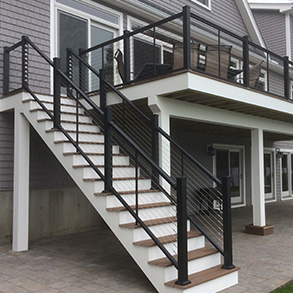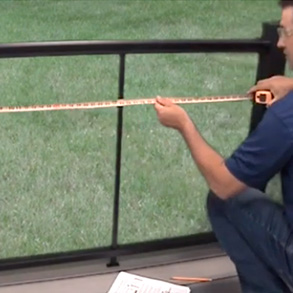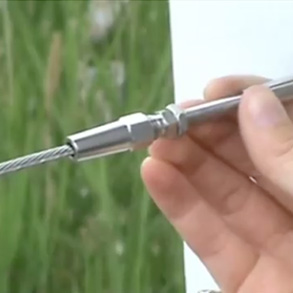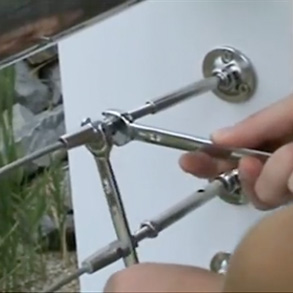CABLE RAILING DIY GUIDE
Cable Railing DIY Success – Let’s Get Started
Cable railing is one of the most unique railing systems available today. A DIY cable railing project is best taken in stages, with planning being the first and usually most important stage, followed by material selection, material acquisition and installation. Even if you use a contractor to install your cable railing, you can still participate in the planning stage. The cable railing DIY guide steps are detailed below. They are quite easy and hopefully fun.
Always refer to your local building code officials prior to installing any Atlantis Rail system to ensure all code and safety requirements are met. Atlantis Rail Systems is not responsible for improper or non-recommended installations.
PLANNING AND DESIGNING YOUR CABLE RAILING
- Set your sights on a cable railing design before you start to apply it to your project. Cable railing is one of the few building materials completely open to the imagination. Many DIY cable railing projects are completely unique based on the application of multiple materials in the design. Stay traditional or be bold, it’s your choice.
- Be realistic with your budget, but remember, stainless steel is not the least expensive building material available and the other elements of your project should reflect that as well. If intending to use a wood frame for your system, select quality material and understand that stainless steel will last much longer than a lower end wood frame. See Selecting Lumber for a Cable Railing Frame.
- Create economic and aesthetic value in your design by using features developed by the Atlantis Rail engineering team. Cable stabilizers, multiple top rail choices, multiple post designs, and multiple cable components can be combined to increase aesthetic value and increase economic value, or both.
- Make a birds eye sketch on our Express Quote Request Form of your project lay out including the elements you want to include in your design. Hand sketches are acceptable. Click here for an example.
- Visit our Photo Gallery to view what other customers have done with the elements you have chosen. Get a good picture of the materials, colors and preferences that will bring your DIY cable railing project to life.
- Submit your DIY cable railing sketch to Atlantis Rail for review. At this stage, our trained professional staff will provide guidance regarding your choices and you will receive a detailed take-off and quote based on your request.



PLANNING YOUR INSTALL
- Assessing the work to be done and your skill level. Many people have experience in carpentry, mechanics and other skills that lend themselves to understanding a cable railing installation. There is nothing difficult about a basic cable railing install if you follow the instructions.
- Assessing the project. Is the railing frame wood and are you building it yourself? Are you using an existing frame and replacing the traditional infill? Have you selected a railing design utilizing Atlantis Rail post and rail sets?
- Assessing your skills. Did you build the frame? If you have the skill to build the frame you likely have the skill to install the cable on it. If buying post and rail sets from Atlantis Rail, have you installed similar product before or do you have skilled experience that lends itself to this project? Our best practices suggestion is to review all installation instructions and videos available before assessing your skills for the job at hand. If you have made it this far, your confidence is likely high and most of our DIY customers have great success.
- Check your tool bag. Atlantis Rail sells some basic tools that are worth their weight in gold when doing an installation. For RailEasy™ cabled railing systems, a template is a must have and costs $18.99. Also a small set of hand tools is available that will ensure a clean install and cost $16.99. Cable cutters are available at varying prices, but there are other valid methods of cutting cable.

ACQUIRING MATERIALS
- Get a free take off and quote. If you have not done so already, complete an Express Quote Request Form and submit it to Atlantis Rail. We will in turn provide you a detailed take-off and a quote with all of your needed supplies listed.
- Purchase form your local dealer. When purchasing from one of our authorized dealers, it is helpful to provide them with the quote number so we can ensure you get the correct material. If you are utilizing Atlantis Rail post or rail sets, there are lead times involved in some cases.
INSTALLING YOUR DIY CABLE RAILING
- Review install instructions and videos. If you have followed all of the steps in the planning stage, you are well acquainted with installation instructions and available videos. Print a set to have available during install or you can view them on your smart phone or tablet if questions arise.
- Lay the project out. Place boxed materials, including post and rail sets, where they are to be installed, using your free take-off as a guide.
- Check your tools. Make sure you have all tools required before beginning the installation.
Hint: If you are drilling more than 6 mid posts, it is recommended that you acquire multiple high quality drill bits before beginning. One bit will do approximately 6 posts (approximately 60 through-post holes).



DIY CABLE RAILING INSTALLING TIPS
Atlantis Rail installation instructions and videos should be your main reference, but there are several tips that will make your install go easier. Most of these are review from the instructions.
- Use the available drilling template to mark your locations.
- When drilling through holes in mid post, go very slow and drill from both sides.
- Use sharp, high quality bits for through-post holes.
- Readily available drill guides may help with drilling through-post holes.
- Use cable lacing needles to avoid damaging ends of cable when feeding through through-post holes.
- Always wash your new cable railing immediately after installation. See the Stainless Steel Rail Care Guide or Powder Coated Stainless Steel & Aluminum Products Rail Care Guide for more maintaining your cable railing system.